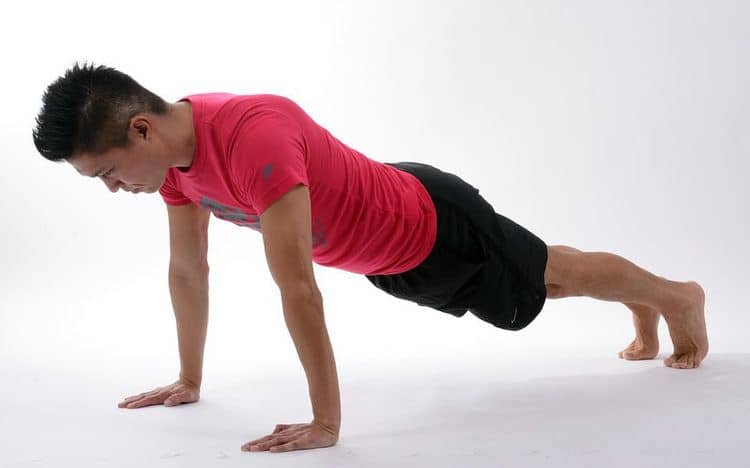When you walk into a gym anywhere in the world, the first exercise you are likely to see performed is the bench press.
The bench press is the standard for increasing upper body pushing strength. It is the number one choice for building big and strong pecs, triceps and deltoids.
However, if you are only doing the bench, you are severely shortchanging your progress both in strength and muscle size – and potentially setting yourself up for injury.
Instead, learn how to increase your bench, build more muscle and prevent unnecessary setbacks.
The secret to healthy shoulders
Don’t get me wrong. I think that the bench press is awesome in every way, too.
But unfortunately, it doesn’t offer complete development of your pushing strength.
To understand why, you must first understand the difference between open kinetic chain (OKC) exercises and closed kinetic chain (CKC) exercises. We will look at examples involving the upper body.
- Closed chain exercises are exercises where your hands are fixed. A perfect example is the push up: your hands are firmly placed on the floor while your arms move to push the rest of your body.
- In open chain exercises, the hands are not fixed. They are free to move in space, which puts certain stability requirements on the body.
An example of an OKC exercise is the bench press. Done with proper form, the point of stability is the contact point between your back and the chest.
And therein lies the problem.
Benching with proper form means retracting your shoulder blades and fixing them firmly on the bench. That provides a stable surface from which you can push off.
But that technique (which is absolutely correct), eliminates a crucial part of human pushing movement: protraction.

Put your arms out in front of you and straighten them out. Now, try to reach as far in front as you can. You will notice that your shoulders moved forward. That is protraction.
Protraction trains a muscle that is very important to overall shoulder health: the serratus anterior (SA). Often called the “boxer’s muscle”, it keeps the shoulder blades sliding smoothly on the ribcage. In short, it allows for proper movement.

If your serratus is weak, the result is scapular winging. Scapular winging is a serious problem and if undiagnosed can lead to rotator cuff injuries like SLAP lesions and impingement.
Ok, here’s what we know so far: we need a strong SA and the bench press doesn’t train it.
What can we do about it?
Enter the push up

I can already see some of you rolling your eyes and wondering if, somehow, you travelled back in time to elementary school gym class.
But the hate is unwarranted, as the push up is one of the best exercises you could be doing, period.
It builds shoulder stability, which will in turn increase your bench press. It trains your shoulders through full range of motion – if you do them correctly.
What is correct form then? Remember what I told you about protraction? Now, do the same drill as before, but do it in the plank position.
Just to remind you, here are the keys to a perfect plank (and the perfect push up):
- Keep your body straight. Tuck your chin in, tuck your butt under, straighten your legs and keep the core tight. Your body should be a single like from head to toes.
- Extend your arms fully, don’t allow the elbows to bend.
And here’s how it looks like:

Now, do the same as before: try to push your arms as far away from you as possible. You can also think of pushing your body away from the ground. Remember, only move from your shoulder.
The top position is how you should finish all your pushups if you want maximum serratus anterior activation (and you do).
All that is left is to do the push up.
Remember these keys:
- Keep your elbows close to the body.
- Chest touches the ground.
- Push back up to the plank position we discussed before.
Wrong:

Right:

Also, to maximize SA activity, do your push ups with hands rotated externally.
You might discover that suddenly, push ups are much more difficult that before. If you do them correctly, you won’t need to do much to see great results.
Throw in 3-5 sets after you bench press and you will see gains both in strength and size. As a side (or main, depending how you look at it) benefit, you shoulders will be much healthier.
Lots of reps is very beneficial for your joints recovery and building muscle, but if regular push ups ever get too easy, there are many ways to make them hard again.
When you can do over 15-20 pushups per set (remember, perfect form), you can either:
- Start adding weight with a weight vest or a weight belt
- Move your arms closer to your hips (these are called pseudo planche push ups)
- Progress to one arm pushups
Push your way up to success
No matter how strong or jacked you are, if you get injured, you lose both. That is why health and performance should be your number one priority.
Not because they are sexy; they aren’t. They are the gritty, unglamorous work that no one wants to do. But it is the gritty work that makes all the stuff you actually want to do possible.
Bench press is cool, but so is the push up. Endure the ’’boring’’ parts so you can kick ass on the exercises that matter to you. We promise it will pay off.